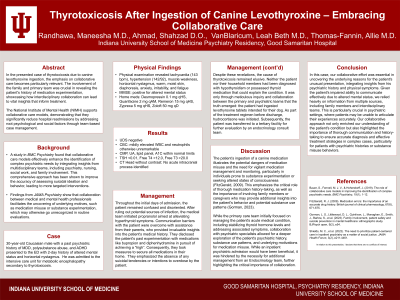Substance Use and Related Disorders
(176) Thyrotoxicosis after Ingestion of Canine Levothyroxine – Embracing Collaborative Care

- MR
Maneesha Randhawa, MD (she/her/hers)
Psychiatry Resident PGY-3
Indiana University School of Medicine- Vincennes Psychiatry Program
Vincennes, Indiana 
Leah Beth Vanblaricum, MD
Resident
Indiana University School of Medicine
olney, Illinois- SA
SHAHZAD AHMAD, D.O.
Resident
Indiana University
Newburg, Indiana - AT
Allie Thomas-Fannin, MD
Program Director
Indiana School of Medicine- Vincennes Psychaitry Program
Vincennes, Indiana
Presenting Author(s)
Co-Author(s)
Treatment Course: After ruling out potential sources of infection, the medical team initiated propranolol aimed at alleviating hyperthyroid symptoms. Throughout the initial days of admission, the patient remained confused and disoriented. Communication barriers with the patient were overcome with assistance from their parents, who provided invaluable insights into the patient's medical history. They disclosed the patient's past experimentation with medications like bupropion and diphenhydramine in pursuit of achieving a “high”. Consequently, they took measures to secure all medications in their home. They emphasized the absence of any suicidal tendencies or intentions to overdose by the patient. Despite these revelations, the cause of thyrotoxicosis remained elusive. Neither the patient nor their household members had been diagnosed with hypothyroidism or possessed thyroid medication that could explain the condition. It was only through meticulous inquiry and collaboration between the primary and psychiatric teams that the truth emerged: the patient had ingested levothyroxine tablets intended for their dog. As part of the treatment regimen before discharge, hydrocortisone was initiated. Subsequently, the patient was transferred to a tertiary facility for further evaluation by an endocrinology consult team. FitzGerald, R. J. (2009). Medication errors: the importance of an accurate drug history. British journal of clinical pharmacology, 67(6), 671-675. Gorman, L. S., Littlewood, D. L., Quinlivan, L., Monaghan, E., Smith, J., Barlow, S., ... & Kapur, N. (2023). Family involvement, patient safety and suicide prevention in mental healthcare: ethnographic study. BJPsych open, 9(2), e54.
Background: Individuals with a history of psychiatric disorders and substance misuse/abuse are at an elevated risk of engaging in suicidal behaviors. Healthcare providers must recognize this risk through collaborative care; involving other medical disciplines, detailed medication history, exploring past suicidal behaviors, and obtaining relevant history from family members.
Case Presentation: 30-year-old Caucasian male with a past psychiatric history of MDD, polysubstance abuse, and ADHD presented to the ED with 2-day history of altered mental status and horizontal nystagmus. He was admitted for metabolic encephalopathy secondary to thyrotoxicosis.
Discussion: This case highlights the importance of interdisciplinary collaboration between medical and psychiatric teams in both uncovering an underlying cause and implementing effective treatment. The patient’s ingestion of a canine medication illustrates the potential dangers of medication misuse and the need for vigilant medication management and monitoring, particularly in individuals prone to substance experimentation or seeking altered states of consciousness (FitzGerald, 2023). This emphasizes the critical role of thorough medication history-taking, as well as the importance of involving family members or caregivers who may provide additional insights into the patient's behavior and potential substance use patterns (Gorman, 2023). While the primary care team initially focused on managing the patient's acute medical condition, including stabilizing thyroid hormone levels and addressing associated symptoms, collaboration with psychiatric specialists allowed for a deeper exploration of the patient's psychiatric history, substance use patterns, and underlying motivations for medication misuse. While an inpatient psychiatric admission would have been beneficial, it was hindered by the necessity for additional management from an Endocrinology team, further highlighting the critical importance of collaboration.
References:
Presentation Eligibility: Not previously published or presented
Diversity, Equity, and Inclusion: Substance use disorders and psychiatric disorders can affect individuals from all walks of life, regardless of age, gender, race, ethnicity, socioeconomic status, or sexual orientation. This diversity highlights the universality of mental health issues and the need for inclusive approaches to prevention, treatment, and support.

